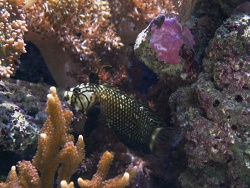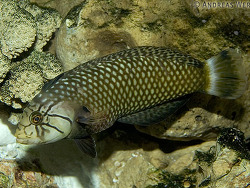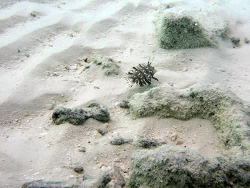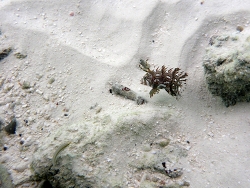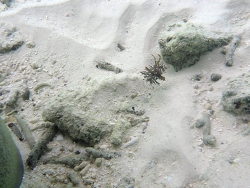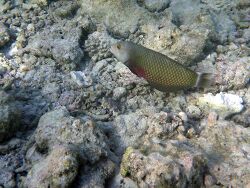Info
Lacepède, 1801)
The English name "rockmover wrasse" refers to its behavior of overturning small rocks and reef fragments in search of prey. The tree wrasse is the only known member of its genus. The wrasse is a colorful fish with a size of 27-30 cm. It has an elongated, laterally compressed body and a wedge-shaped head. Its head is scaleless, apart from two scales on the upper part of the gill covers and an almost vertical row of small scales behind each eye.
Juveniles and adults have a completely different appearance. In juveniles, the first two dorsal fin spines are long and outstretched and hang over the forehead of the fish. As they mature, the elongated rays are lost. The adult fish has a dark greenish-brown body with an elongated white spot on each scale. Its head is gray-blue with brown lines extending from the eyes. There are two black spots in front of the dorsal fin and a broad vertical white stripe at the base of the caudal fin. The rear part of the caudal fin and the ventral fins are black. Juveniles found in Hawaii are usually green and in the Western Pacific they are burgundy to brownish in color. Both are spotted white.
Adult fish live on shallow, semi-exposed reef flats as well as in lagoons and seaward reefs. They prefer seagrass areas with hard bottoms of mixed sand and rubble, which are exposed to light surf. Juveniles prefer shallow areas on rubble between large reefs or sheltered open areas on reef crests. Juveniles resemble algae and mimic the movements of detached, drifting algae by moving back and forth in the currents.
Although little is known about the reproduction of these fish, like other wrasses, they are probably capable of changing sex and are pelagic spawners, releasing eggs and sperm into the water column. These fish have strong territorial behavior and adult pairs often protect large reef areas.
The fish feed on benthic invertebrates, including molluscs, crabs and polychaete worms.
Andreas Werth made the following comment:
This tree wrasse (Novaculichthys taeniourus) was in the process of creating coral rubble on a small mound. It is considered to be a strong builder, creating caves and burrowing into the substrate to sleep. This photo shows him at work: a broken piece of coral was obviously in his way. And although this was also a heavy lump for him, he managed to move the piece out of the way using jerky movements and his entire body.
Conclusion: A fish for a species tank with lots of sand and no sensitive invertebrates.
Females have a reddish-purple spot on the front part of the belly, directly behind the pectoral fins, males do not!
Synonyms:
Hemipteronotus taeniourus (Lacepède, 1801)
Hemipteronotus taeniurus (Lacepède, 1801)
Julis bifer Lay & Bennett, 1839
Labrus taeniours Lacepède, 1801
Labrus taeniourus Lacepède, 1801
Novaculichthys bifer (Lay & Bennett, 1839)
Novaculichthys taeniorus (Lacepède, 1801)
Novaculichthys taeniurus (Lacepède, 1801)
Novaculichtys taeniorus (Lacepède, 1801)
Xyrichthys taeniouris (Lacepède, 1801)
Jumping guard
A jumping guard prevents (nocturnal) fish from jumping out.
Wrasses, blennies, hawkfishs and gobies jump out of an unprotected tank in fright if their night rest is disturbed, unfortunately these jumpers are found dried up in the morning on carpets, glass edges or later behind the tank.
https://www.korallenriff.de/en/article/1925_5_Jump_Protection_Solutions_for_Fish_in_the_Aquarium__5_Net_Covers.html
A small night light also helps, as it provides the fish with a means of orientation in the dark!
The English name "rockmover wrasse" refers to its behavior of overturning small rocks and reef fragments in search of prey. The tree wrasse is the only known member of its genus. The wrasse is a colorful fish with a size of 27-30 cm. It has an elongated, laterally compressed body and a wedge-shaped head. Its head is scaleless, apart from two scales on the upper part of the gill covers and an almost vertical row of small scales behind each eye.
Juveniles and adults have a completely different appearance. In juveniles, the first two dorsal fin spines are long and outstretched and hang over the forehead of the fish. As they mature, the elongated rays are lost. The adult fish has a dark greenish-brown body with an elongated white spot on each scale. Its head is gray-blue with brown lines extending from the eyes. There are two black spots in front of the dorsal fin and a broad vertical white stripe at the base of the caudal fin. The rear part of the caudal fin and the ventral fins are black. Juveniles found in Hawaii are usually green and in the Western Pacific they are burgundy to brownish in color. Both are spotted white.
Adult fish live on shallow, semi-exposed reef flats as well as in lagoons and seaward reefs. They prefer seagrass areas with hard bottoms of mixed sand and rubble, which are exposed to light surf. Juveniles prefer shallow areas on rubble between large reefs or sheltered open areas on reef crests. Juveniles resemble algae and mimic the movements of detached, drifting algae by moving back and forth in the currents.
Although little is known about the reproduction of these fish, like other wrasses, they are probably capable of changing sex and are pelagic spawners, releasing eggs and sperm into the water column. These fish have strong territorial behavior and adult pairs often protect large reef areas.
The fish feed on benthic invertebrates, including molluscs, crabs and polychaete worms.
Andreas Werth made the following comment:
This tree wrasse (Novaculichthys taeniourus) was in the process of creating coral rubble on a small mound. It is considered to be a strong builder, creating caves and burrowing into the substrate to sleep. This photo shows him at work: a broken piece of coral was obviously in his way. And although this was also a heavy lump for him, he managed to move the piece out of the way using jerky movements and his entire body.
Conclusion: A fish for a species tank with lots of sand and no sensitive invertebrates.
Females have a reddish-purple spot on the front part of the belly, directly behind the pectoral fins, males do not!
Synonyms:
Hemipteronotus taeniourus (Lacepède, 1801)
Hemipteronotus taeniurus (Lacepède, 1801)
Julis bifer Lay & Bennett, 1839
Labrus taeniours Lacepède, 1801
Labrus taeniourus Lacepède, 1801
Novaculichthys bifer (Lay & Bennett, 1839)
Novaculichthys taeniorus (Lacepède, 1801)
Novaculichthys taeniurus (Lacepède, 1801)
Novaculichtys taeniorus (Lacepède, 1801)
Xyrichthys taeniouris (Lacepède, 1801)
Jumping guard
A jumping guard prevents (nocturnal) fish from jumping out.
Wrasses, blennies, hawkfishs and gobies jump out of an unprotected tank in fright if their night rest is disturbed, unfortunately these jumpers are found dried up in the morning on carpets, glass edges or later behind the tank.
https://www.korallenriff.de/en/article/1925_5_Jump_Protection_Solutions_for_Fish_in_the_Aquarium__5_Net_Covers.html
A small night light also helps, as it provides the fish with a means of orientation in the dark!







 François Libert, Frankreich
François Libert, Frankreich




